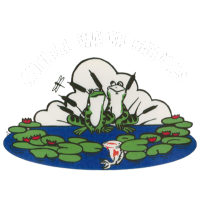Pond Fish
Koi and Shubunkin
Koi and Shubunkin sound like a rock band from the ‘70s, but don’t get too excited… the two are actually ornamental pond fish — very colorful, hardy, graceful and easy to raise. And both are a great choice for water gardens throughout all four seasons in our area.
Fish are a natural complement to having a water garden and provide a valuable and necessary balance in your pond’s ecosystem. Natural Water Gardens ponds are normally three to four feet deep, which allow the fish to live and hibernate throughout an icy upper Midwest winter. Here’s more Koi and Shubunkin fun fish facts…
Koi — A distant cousin of the common coldwater carp, koi were domesticated in China and Japan for thousands of years, although ornamental breeding for color was fairly recent. In the 1800s koi became popular in Europe and eventually were introduced to North American garden ponds during the 20th century. Properly cared for, koi can live for over 70 years.
Shubunkin Goldfish — Breeding goldfish began in China over 1,000 years ago. The hardy Shubunkin breed was developed in Japan during the early 1900s. American Shubunkin goldfish have slender bodies and a lengthy flowing single tail. Their coloration is a calico pattern with vibrant patches of black, violet, orange and red, with a predominant blue background color.
Fish Care and Feeding – Do’s and Don’t’s
Do make sure you let them float on top of your pond in the bag you brought them home in for 15-20 minutes to acclimate them to your pond water temp. If it’s hot outdoors, you’ll need to cover the bag for shade so you don’t poach the fish. Don’t empty the water from the bag directly into your pond. Remove the fish with a net and then transfer them to your pond.
Coming out of long winter hibernation there’s a tendency for the fish to be stressed. Feed them a medicated fish food for the first week as soon as the water is above 50 degrees to help them overcome stress.
Don’t overfeed your fish. Feed them once or twice daily and only what they can consume in a 3-minute period. These fish are your pets, so be kind to them. We get very upset if we happen to have sick fish. It’s best to take sick fish out of your pond and treat accordingly:
Simply put the sick fish in a bucket or container to treat the ailment. You’ll also want to treat your pond so the other fish do not become infected. Make sure to add dechlorinator to tap water in new ponds or ponds that have been cleaned and refilled to reduce chlorine and chloramines which can be fatal for your fish. Some dechlorinators also remove heavy metals and help improve the slime coat on your fish.
Fish Diseases & Parasites
Ich is the most common of all fish diseases. It’s characterized by tiny white spots on the fish’s skin. Symptoms include: rubbing against rocks, lethargy, and loss of appetite. Recommended treatment is a salt bath. Add 10 pounds of salt to your pond for three days. Do a water change in two weeks to remove some of the salt.
Flukes are the most common parasite found on Koi and goldfish. Symptoms include: flashing (when the fish rub their sides on the pond floor and you get a flash of light off the scales), gasping at the surface, frayed fins, and sometimes death. Recommended treatment is a salt dip. Add 10 tablespoons of non-iodized salt per gallon of water in a basin and dip the fish in the solution for 3-5 minutes, or until the fish starts rolling over. Repeat this process twice more at 12 hour intervals.
Bacterial infection symptoms include: fin and tail erosion, redness of tail, pectoral or anal fins, and open red ulcer sores. Recommended treatment is feeding your fish medicated food for 10-14 days.
Natural Water Gardens staff can answer your fish questions. Contact us or visit our retail center to select food and products to keep your fish healthy and happy!
